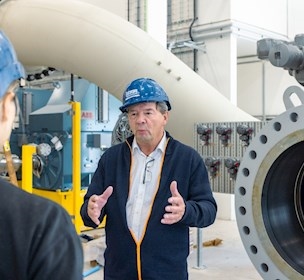Highlights from the (re)calibration workshop 2017
80 manufacturers, gas end-users and metrology experts from over 20 countries gathered for the (re)calibration workshop 2017 in Denmark. If you missed it – here are the highlights from the event.
(Re)calibration is a world-wide topic
The benefits of calibration and recalibration of gas meters are considered high world-wide - more than 80 industry representatives from over 20 countries could agree on that.
The experience levels are very diverse though, from initial inquiries in Iran, to many years of experience in Germany. In both scenarios – and for all in between – (re)calibration poses challenges in regards to the metrological, technical, legislative and mechanical point of view – but also opportunities.
5 highlights from the (re)calibration workshop
If we are to sum up the absolute highlights from the event, we would emphasize:- Expanding of the global network: The diversity of the participants from over 20 countries and from all levels in the value chain made it an obvious platform for broadening our network in the industry.
- Learning without prejudice: The open and relaxed atmosphere for discussions gave all participants opportunity to share mutual understandings and interests in an open forum.
- Getting facts right on metrology: Distinguishing between different aspects of metrology, including legal and non-legal metrology, type approval and metrology in contracts between two parties.
- Understanding guidelines: Guidelines within non-metrological areas are not binding, but guiding. To be agile in the gas value chain, you need to let your self be guided to the best possible solution but not be limited by guidelines.
- Still learning: The shared best practices, national legislation and experiences made us conclude, that re-calibration is still under development, but a very important parameter in the natural gas value chain
So, what did we learn on the workshop?
If you missed the workshop, here is a short resume.
End-users like Energinet and Gas-Souzan presented experiences with determining recalibration intervals on meters, studies of meter stability and interpreting guidelines and rules for custody transfer, national as well as international.
Manufacturers SICK and KROHNE shared best practices with re-calibration on permanent series connection of Ultra Sonic Meters, and how to cope with national and international guidelines when working with series connections. On the agenda were also advantages of skid verification on calibration rigs, and how installations affect the calibration results.
PTB tested our knowledge of gas calibration - what is true and what is urban legend? Can calibration labs measure correctly without re-calibration? And can national standard institutes disseminate the meter accuracy without re-calibration?
Finally, calibration laboratories such as FORCE Technology, Pigsar and NEL, took us on a calibration journey and described how calibration of gas meters has evolved during the last 30 years, how the number of requests is increasing, how national and international regulations affect the market, and which advantages and disadvantages exist with different types of test rigs.
And of course, a lot more…
If you want to see the details, find pictures and presentations here.

